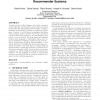Free Online Productivity Tools
i2Speak
i2Symbol
i2OCR
iTex2Img
iWeb2Print
iWeb2Shot
i2Type
iPdf2Split
iPdf2Merge
i2Bopomofo
i2Arabic
i2Style
i2Image
i2PDF
iLatex2Rtf
Sci2ools
RECSYS
2015
ACM
2015
ACM
"Where Far Can Be Close": Finding Distant Neighbors In Recommender Systems
Location and its corollary, distance, are critical concepts in social computing. Recommender systems that incorporate location have generally assumed that the utility of locationawareness monotonically decreases as entities get farther apart. However, it is well known in geography that places that are distant “as the crow flies” can be more similar and connected than nearby places (e.g., by demographics, experiences, or socioeconomic). We adopt theory and statistical methods from geography to demonstrate that a more nuanced consideration of distance in which “far can be close” – that is, grouping users with their “distant neighbors” – moderately improves both traditional and location-aware recommender systems. We show that the distant neighbors approach leads to small improvements in predictive accuracy and recommender utility of an item-item recommender compared to a “nearby neighbors” approach as well as other baselines. We also highlight an increase in recommen...
| Added | 17 Apr 2016 |
| Updated | 17 Apr 2016 |
| Type | Journal |
| Year | 2015 |
| Where | RECSYS |
| Authors | Vikas Kumar, Daniel Jarratt, Rahul Anand, Joseph A. Konstan, Brent Hecht |
Comments (0)

